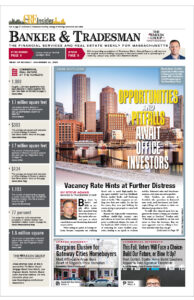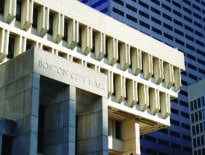Linda Orel
Chief Impact Officer, Boston Harbor Now
Industry experience: Over 20 years
Linda Orel was recently appointed as Boston Harbor Now’s first chief impact officer. Orel comes to the nonprofit with a background in lobbying around climate resilience issues and historic preservation. In her most recent role as senior policy advisor at the Trustees of Reservations, she advocated for nature-based climate resilience, land conservation and ecological restoration on Beacon Hill and in collaboration with other nonprofit partners. Boston Harbor Now focuses on using green infrastructure to protect communities and buildings from the impacts of climate change. The nonprofit’s newly released vision for the waterfront, called “Harborwalk 2.0,” lays out ideas to improve public access to the 40-mile waterfront.
Q: Why did you take this position?
A: I was very excited to work with Boston Harbor Now to help implement their long-term goals. I was excited to join now because Boston Harbor Now is in the middle of this strategic plan to determine what the priorities will be for the organization over the next three to five years. I’m inspired by Kathy Abbott, the president of Boston Harbor Now, who I’ve known for a long time. As a mentor to me, I would consider her a legend in the community. So, I was excited to work for Kathy and I love Boston. I was raised near Boston, and I lived in the city for 18 years. It’s my city, it’s my home. I care very much about the impacts of climate change on the waterfront and the city and the neighborhoods throughout Boston.
Q: How is your background in climate resilience, advocacy and government affairs going to inform your work at Boston Harbor Now?
A: There’s a few ways my background will help me with this work. One is to influence local, state and federal policy, working with stakeholders and partners. Another is creating new sources of public funding to have a greater impact, whether that is to protect, conserve and restore natural resources or influence policy to use green infrastructure or nature-based climate solutions to protect communities from climate impacts. And the third one that I worked on recently at the Trustees is regulatory reform. We really want to make it easier for all partners – nonprofit, private, local, state and federal – to work together collaboratively to implement nature-based climate solutions to enable communities around the waterfront to become more resilient to inevitable climate impacts. And right now it can take a long time to get permits – some permits are difficult to get. We are working at Boston Harbor now on streamlining the regulatory permitting process on regulatory reform initiatives.
Q: What level of state and local collaboration do you think is necessary to align funding for the waterfront?
A: I don’t think that we can do it without all levels of government and private entities getting together to put together a funding matrix. It will cost billions of dollars to make the waterfront more resilient to climate impacts. I don’t think there’s any one agency or one level of government [that can do this]. For example, I don’t think only the city of Boston is equipped to take all this on without other partners. I think it’s going to require coordination between local, state and federal partners, property owners, private interests, nonprofits and universities. I think Boston Harbor Now is the thought leader on the waterfront that can help bring all these partners together, whether through the existing Green Ribbon Commission, or through other existing and potentially future partnerships, and collaborate to identify the sources of funding that are needed now to protect the city before climate change becomes worse.
Q: What do you see as any potential challenges that lie ahead for gaining the necessary support for Boston Harbor Now’s vision for the waterfront?
A: There are other needs for public funding, like affordable housing and transportation improvements, especially public transportation, and there’s only so much money out there. So, I think we need to identify a new source of public funding and instead of only relying on existing sources of public funding. When I was at the Trust for Public Land, my job was to create new sources of public funding. And sometimes you have to get creative. In that particular job we actually went to the ballot and asked voters to approve increased funding for specific purposes. And I don’t know if that is the solution here. But I do think we need to get creative, and really think innovatively with all partners about where funding can come from at the local, state and federal level. And private financing is critically important as well.
Q: One of your organization’s ideas for protecting against coastal flooding calls for a seawall and vegetated berms. What does that look like in practice?
A: We are in very close partnership with the Stone Living Lab. They are scientists and researchers identifying opportunities for nature-based approaches on the waterfront and the islands to protect the city from climate change impacts. Boston Harbor Now works in close collaboration with the Stone Living Lab in bringing together partners and helping to bring these projects to fruition. And that might include working with Stone Living Lab to identify funding opportunities for these projects, to bring together partners who are also interested especially two of our very important partners, the National Park Service at the federal level and the Department of Conservation and Recreation at the state level.
Q: Why is the mission of Boston Harbor Now important to you?
A: I care about protecting communities in Boston and everywhere from the impacts of climate change. And I’ve dedicated my career to helping to resolve these issues. So personally, this is carrying forward my lifelong commitment to using nature-based solutions to protect communities from climate change while creating chances for kids, families, residents and visitors to get outside. Also, I went to college at Northeastern University in Boston, and then following college I lived in the city for 13 more years. When my husband and I got married 17 years ago, we got married on the harbor on a boat. I feel very connected to the city.
Orel’s Favorite Movies and Movie Franchises
- “Mary Poppins”
- Lord of the Rings
- Indiana Jones
- Star Wars
- All the Marvel movies







